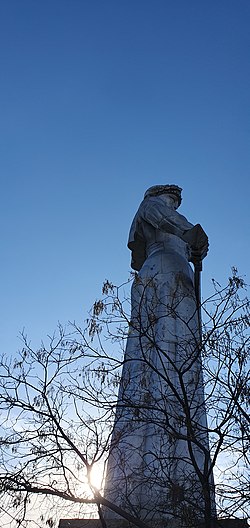Kartlis Deda
| Mother Georgia | |
|---|---|
| Native names | |
 Kartlis Deda | |
| Location | Sololaki Hill, Tbilisi, Georgia |
| Coordinates | 41°41′17.0″N 44°48′16.5″E / 41.688056°N 44.804583°E |
| Built | 1958 |
| Sculptor | Elguja Amashukeli |

Kartlis Deda[1] (Georgian: ქართლის დედა; Mother of Kartli or Mother of Georgia) is a monument in Georgia's capital Tbilisi.
The statue was erected on the top of Sololaki hill in 1958, the year Tbilisi celebrated its 1500th anniversary. Prominent Georgian sculptor Elguja Amashukeli designed the twenty-metre aluminium figure of a woman in Georgian national dress.
Symbolism
She symbolizes the Georgian national character: in her left hand she holds a bowl of wine to greet those who come as friends, and in her right hand is a sword for those who come as enemies.[2]
History
In 1966 Elguja Amashukeli was awarded the Shota Rustaveli State Prize for this sculpture. He called the statue "Capital", and it commonly became known as "Mother of Kartli". The accessories of the sculpture, the cup with wine and sword, are an expression of the history of our city, Tbilisi, the endless battles with the enemies and the welcoming of friendly guests.
The original statue erected on Sololaki Hill in 1958 was a wooden allegorical statue that would temporarily decorate the capital. Later it was decided to become permanent and the wood texture was covered with aluminum in 1963 to limit environmental damage. In 1997, the old statue was replaced with a new one. [3]
See also
References
- ^ It has been argued that the original name was Kartvlis Deda, meaning "Mother of a Georgian", but this rendition never entered mainstream use. See: Georgian Soviet Encyclopedia, Volume 1, p. 350, Tbilisi, 1975
- ^ David J Constable, « Kartlis Deda: The Importance of Georgia's Most Famous Woman », huffingtonpost.co.uk, 21/08/2012
- ^ « Kartlis Deda (Mother of Kartli) », georgiantravelguide.com, 16/02/2020

